NATO is devising military plans to address the risk of military escalation at its eastern border. An important consideration is the extent to which NATO allies can bring their military mass, a crucial component of operational planning, to the battlefield in the Baltic Sea region. Analysis indicates that the Russian military can potentially disrupt NATO’s ground, maritime, and aerial lines of communication more extensively than commonly perceived. This article aims to contribute to a better understanding of the Russian General Staff’s ability to interdict NATO force projection.
As the 1944 Allied Operation Overlord of the Second World War approached, many Allied bombers’ missions shifted from targeting German industry to transportation systems.[1] The aim was to prevent the German military from reinforcing the French beaches where the Allies intended to establish a foothold. The Transportation Plan, approved by Supreme Allied Commander Europe Dwight Eisenhower despite strong opposition from strategic bomber enthusiasts who preferred to allocate resources to German industry, aimed to target logistical nodes, including roads, railroads, and bridges necessary for transporting German troops. The plan was successful: from March 1 to the start of Operation Overlord on D-Day, total traffic on French railroads decreased by 60 percent.[2] Subsequently, Gerd von Rundstedt, the Commander of the German forces, lamented the Allied invasion in Normandy stating that he ‘prepared for various eventualities…that all came to nothing…by the destruction of railway communications…’[3]
Military interdiction is a strategy that prevents an opponent from bringing its full military potential to the battlefield.[4] The goal is to deny a position of advantage by preventing opposing forces and supplies from arriving at the place of combat when needed.[5] Eisenhower’s Transportation Plan exemplifies air interdiction, but the Second World War’s history brims with ground and maritime examples achieving similar effects across all domains. Operation Overlord also saw ground interdiction with sabotage activities of partisans in France targeting specific bridges or railroads. German maritime interdiction hampered US support to the UK and the Allied efforts during the Battle of the Atlantic. In March 1942 alone, German U-boats caused a loss of about a half million tons of Allied shipping.[6]
Currently, NATO is devising military plans to address the risk of military escalation at its eastern border. An important consideration is the extent to which NATO allies can bring their military mass, a crucial component of operational planning, to the battlefield in the Baltic Sea region. While Eisenhower’s Transportation Plan is an example of Western interdiction, this article aims to contribute to a better understanding of the Russian General Staff’s ability to interdict NATO force projection. Analysis indicates that the Russian military can potentially disrupt NATO’s ground, maritime, and aerial lines of communication more extensively than commonly perceived. Highlighting this thesis, this article first discusses NATO force projection of ground, maritime, and air forces into the Baltic Sea region and potential corridors for reinforcing the Baltic States. Second, it outlines how Russian threat perception over the past three decades shaped design principles for its military. During this period, NATO militaries focused mainly on executing counterinsurgency operations, requiring a specific force design. The political developments in Europe secured by default NATO’s eastern flank. In contrast, the Russian military never refrained from military planning vis-à-vis NATO. The third part of this article discusses a small cross-section of Russia’s weapon systems for interdicting NATO’s ground, maritime, and air forces. The Russian General Staff has developed and deployed specific capabilities to address the military problem of NATO force projection in these three domains. Lastly, this article recommends four measures for NATO planners to help them think through how to address better the imposition of costs on their battlefield plans.

Polish Army BMP-1 Infantry Fighting Vehicles at the Lithuanian rail yard of Mockava during exercise Brilliant Jump 20, designed to test the deployment time of NATO’s Very High Readiness Joint Task Force. Photo NATO
Two key elements frame this article. First, it confines itself to the three traditional military domains. While NATO’s operational planning also encompasses the cyber and space domain, the authors focus on ground, maritime, and air lines of communications that enable force projection. Second, the geographical focus of the analysis is the Baltic Sea region. The Russian General Staff’s ability to interdict extends across its entire border to some extent. However, with Finland and Sweden joining NATO, the epicenter of conflicting security interests with Western countries, from a Russian viewpoint, is in this region. From a military perspective, it underscores the encirclement of Russian sovereign territory in Kaliningrad by what they perceive as an aggressive alliance. While this may seem implausible from a Western perspective, given that NATO is a defensive alliance, strategic depth has historically been crucial to Russia’s state survival. Indeed, this depth has significantly reduced over recent decades.
Projecting force in the Baltic Sea region
Force projection refers to a nation’s capacity to mobilize its forces, deploy and employ them for specific tasks, sustain them over time, and redeploy them once military operations have ceased.[7] At present, the US military can project power on a global scale, and it is arguably the only military worldwide capable of doing so.[8] Notable examples of force projection in recent history are the 1991 operations Desert Shield and Desert Storm. Within a few months, the US military and its allies mobilized forces, deployed them thousands of kilometres away from their home base in Saudi Arabia, employed and sustained them over time to liberate Kuwait, and redeployed them after the cessation of operations. However, these operations unfolded in an operational environment with relatively few military threats. In contrast, a potential force projection operation in the Baltic Sea region would face a significantly higher military threat, consisting of advanced weapon systems operating across all domains. Given this heightened military threat, it is crucial to consider how NATO could project forces to uphold its principle of collective defence. As each service operates differently, the next section aims to enhance understanding of how each service projects forces up to and during a potential Article 5 scenario.
Projecting ground forces
Conceptually, force projection of ground forces involves four components: from fort to port, port to port, and port to theatre. Upon arrival in the theatre, the fourth component is the reception, staging, onward movement, and integration (RSOI) process, which prepares forces for supporting the battlefield commander’s operation.

Figure 1 The concept of force projection using road/railroad movement, sea or airlift
Consider a hypothetical scenario where the 1st US Armored Division deploys from its fort to the Baltic Sea region. Stationed at Fort Bliss, Texas, the 1st US Armored Division transports its approximately 3,500 combat vehicles and 17,000 personnel to the port of Houston, Texas, or a military airfield. Military planners have two options when transporting large numbers of troops and equipment across oceans: strategic sealift with large ships and strategic airlift with cargo planes. For the 1st Armored Division, strategic sealift is the obvious choice for its material when transporting it from Texas to the Baltic Sea region. Indeed, transporting the division’s vehicles by air would require more C-17s, based on one tank per flight, than the US Transportation Command operates. From the port of embarkation, about four to eight roll-on/roll-off ships would sealift the 1st US Armored Division in approximately 15 days to the port of debarkation in, for example, Bremerhaven, Germany or Vlissingen, the Netherlands. Its personnel would fly in batches, with a small group spearheading the division to prepare its reception in Europe. The port authorities and other host nation support agencies would receive the division in the operations theatre by unloading the combat vehicles and moving them to a marshaling area. After uniting, personnel and equipment are organized into smaller mobile units at a staging area, where they receive logistical support. The size and composition of these units depends largely on the combat mission and the type of threat emanating from the adversary. At a staging area, Russian precision-guided munitions are an important component of the threat to the division. Indeed, organizing small movement units and dispersing them over a large geographical area is prudent. Next, the 1st US Armored Division will move to a tactical assembly area by road or rail, preferably over several routes. Just before entering combat, the division integrates into the battlefield commander’s order of battle and receives the latest intelligence about it’s area of responsibility.
The above hypothetical scenario considers projecting just one ground forces division from the US to the potential battlefield. The logistics needed to support its deployment and sustain it in combat outscale the necessary maneuver components regarding people and equipment and require as much planning, preparation and continuous attention as the maneuver plan does.
Over the past three decades, the US military and its allies have mainly depended on sea and airlift to project force into operational theatres. Nevertheless, the quantity of strategic mobility forces within NATO has declined since 1989 because Cold War operational plans for the defence of Europe required much more forces than the execution of counterinsurgency operations in the Middle East and Africa in the 2000s and 2010s.[9] Currently, the US Transportation Command operates roughly 44 roll-on/roll-off ships for strategic sealift and around 275 C-17s for strategic airlift, which is insufficient for the forces that will likely be necessary for large-scale combat operations against a peer competitor, especially considering there might be more operational theatres simultaneously in need of forces. [10] The sealift fleet is also aging, with an average age per ship of 44.[11] The airlift fleet is longer lasting, with a projected end-of-life cycle of the C-17s in 2050. European militaries have not prioritized any strategic lift capabilities, be it sea, air, rail, or road, in their force development in the past decades, resulting in no significant capability for transporting forces.
Currently, NATO is devising operational plans to execute within the collective defence framework. From 10 to October 19, 2023, NATO’s largest command post exercise of the 21st century Steadfast Jupiter ‘tested NATO’s responsiveness, command and control, and defense posture in a highly challenging multi-threat environment.’[12] One of the main concerns NATO faces is how to deploy the forces of European nations that do not need to travel across the Atlantic like the 1st US Armored Division. The operational plans will assign combat forces a set area of operations, making training the potential tactical mission tasks more effective.[13] However, units need to get there first, and NATO considers rail, road, and inland water routes from west to east as the main modes of transport. Unfortunately, national border crossing legislation makes arriving at the combat area problematic. NATO allies have different national legislation regarding munitions transport, road and rail movement of units, and border crossing requirements. One could imagine that after the invocation of Article 5 many of these regulations will vanish into thin air. However, not everyone shares this view. Additionally, troop movement could already occur before invoking Article 5 for posturing purposes. These legislations negatively affect the readiness to operate considerably as they obstruct military units from reaching their assigned training areas. Luckily, the European Union set in motion several initiatives, such as the Military Mobility and Logistic Hub initiative, to overcome these obstructions. The Russian General Staff, however, is not impeded by similar preparation hurdles.
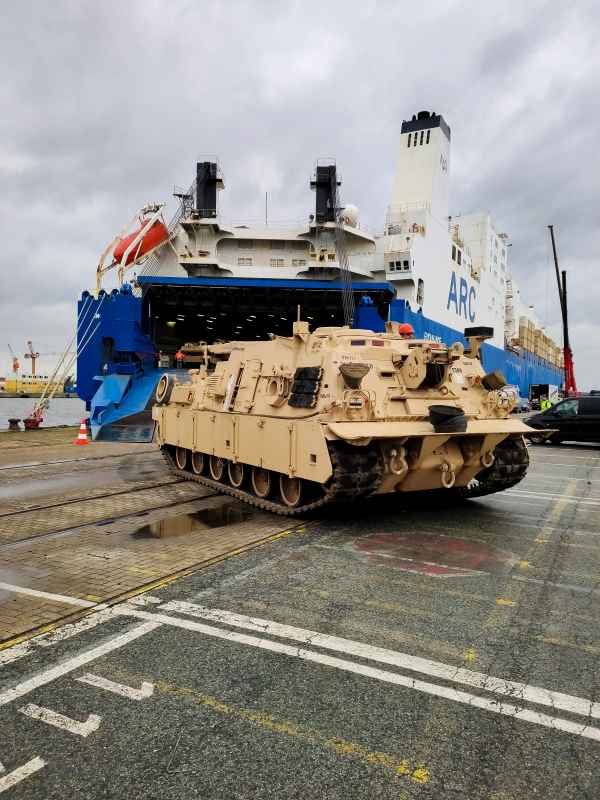
An M2A2 Bradley Infantry Fighting Vehicle disembarks from US vehicle carrier Endurance at the port of Bremerhaven, taking part in DEFENDER-Europe 20, an exercise to improve allied forces’ ability to move quickly across the Atlantic and Europe. Photo NATO
Interestingly, Russia’s approach to military mobility differs significantly from that of the US, with railroads playing a crucial role.[14] This design choice results in a more limited capacity for global force projection. The Russian General Staff supports the Kremlin’s security policy with a mobility strategy that relies heavily on the Railway Troops, utilizing around 85,000 kilometres of railroads in Russia.[15] Indeed, the transportation of troops by rail to the edges of the Russian borders was a key factor in the Russian annexation of Crimea and remains crucial in its ongoing war against Ukraine.[16] In contrast, the US military’s ability to deploy large forces across oceans aligns with the global goals of the 2022 US National Security Strategy. However, the onward movement of units via rail or road transportation to reach their final tactical area of operations across mainland Europe often receives insufficient consideration. In sum, the mobilization and deployment of US ground forces in the European theatre presents challenges due to a lack of military mobility. Additionally, insufficient European harmony in approaching military mobility to get European forces to their tactical combat areas is challenging for NATO’s exploration of how to employ ground forces within the broader operational plans.
Projecting maritime forces
The concept of force projection is more straightforward in the maritime domain than its land counterpart. This is primarily because deploying maritime forces into an operational theatre involves fewer distinct components than ground forces. However, the practical execution of such deployments shares with land forces the enormous complexity of operations at scale. Furthermore, maritime forces significantly impact the balance of forces both at sea and on land. Currently, the US Navy employs Carrier Strike Groups centered on aircraft carriers as their primary forward-deployed task force for force projection.[17] A typical group consists of an aircraft carrier, five or six surface combatants, one or two submarines, and a logistical ship. The aircraft carrier houses an air wing with 40 to 50 fighter jets, several helicopters, and Airborne Warning and Control Systems (AWACS). A Carrier Strike Group offers flexible military response options, as it brings precision-guided munitions for a deep strike capability, intelligence collection, and airpower to a potential battlefield. In times of escalating tensions, a Carrier Strike Group is likely be one of the first naval force packages deployed to the High North. Upon receiving orders, the strike group can cover approximately 750 nautical miles in 24 hours depending on speed, thus enabling operations much faster than a ground forces division from Texas.[18]
Maritime forces from European NATO nations are already present in the operational theatre, given that a potential military conflict with Russia likely encompasses all of Western Europe. Smaller naval fleets from these nations are better suited for operations in the Baltic Sea. However, they face the challenge of being channeled when attempting to reinforce the Baltic States. The only viable option to reach Estonia, Latvia, and Lithuania is to enter the Baltic Sea through the Skagerrak and the Sont, a narrow maritime corridor between Denmark and Sweden. From there, the corridor widens and passes by the German, Swedish and Polish coastlines. Within the Baltic Sea, several ports to major cities offer the option of a sealift to Klaipeda, Riga, and Tallinn. In the hypothetical scenario of Russian forces occupying the entire Baltic States, this military response option would require amphibious assault forces instead of conventional ground forces transported by roll-on/roll-off ships. To be succesfull in this scenario, neutralizing Kaliningrad’s precision-guided missile systems and clearing naval mines is conditional on securing sea lines of communication. Once these sea lines are secure, reinforcements should be ready for deployment from the aforementioned ports.
Projecting air forces
The force projection of air power shares similarities with maritime forces, primarily in its ability to arrive in the operational theatre without the need for strategic air or sealift, unlike ground forces. The unique characteristics of air power are speed, reach, and height. They provide a broad range of military options, making it responsive and easily scalable. However, it’s important to note that air power has limitations, such as impermanence, payload restrictions, and relative vulnerability. For effective deployment of air power, extensive geographical basing near the operational theatre is essential. This strategic positioning allows for optimal utilization of firepower, thereby maximizing the number of adversarial targets at risk. For instance, the approximate combat radius of an F-35A is only 1,000 kilometres.[19] Airfields must be strategically located close enough to the adversary for the fighter-bombers to reach targets but simultaneously sufficiently dispersed to impose operational targeting dilemmas on the adversary. Currently, the US Air Force in Europe, with its headquarters in Ramstein, Germany, operates from two main air bases in the United Kingdom, two in Germany, one in Italy, one in Turkey, and one in Portugal. In NATO’s operational plans, NATO nations must use a multitude of airfields along their border with Russia to enable all of NATO’s air forces, or alternatively a large number of air-to-air refueling capabilities will be needed.
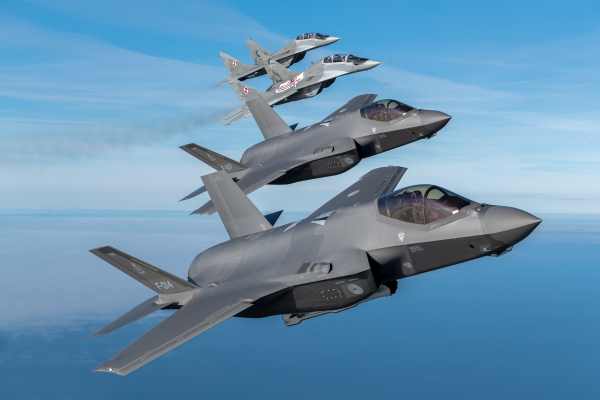
NATO fighters during an air policing mission over Poland, 2023. The F-35 is well suited for SEAD/DEAD operations, Photo MCD, Christian Schrik
While mobilization and deployment are currently the most pressing challenge for NATO planners regarding ground forces, the biggest challenge for aircraft is in employing them with better focus. With the emphasis on stability operations in recent decades, the employment of air forces has centered on close air support of ground forces, intelligence collection, and surgical strikes in threat-free airspace. However, large-scale combat operations against a formidable military adversary necessitate a different mission: Suppression and Destruction of Enemy Air Defences (SEAD/DEAD).[20] SEAD/DEAD targets the adversarial air defence system, such as command and control nodes, radar installations, and Surface-to-Air Missile (SAM) systems. Regrettably, NATO largely depends on the US to execute this mission.[21] Fortunately, several European NATO nations are replacing legacy fighter jets with the F-35, which is well suited for SEAD/DEAD. Indeed, it appears that Lockheed Martin specifically designed the F-35 for this task. An F-35 squadron possesses the capability for an effective targeting process to degrade an Integrated Air Defense System (IADS): a spread-formation of aircraft where the sensor suites cooperate to triangulate SAM radars in real-time and long-range precision strike with Spear-3 or advanced anti-radiation guided missiles with extended range.[22] According to a RUSI analyst, about three F-35 squadrons dedicated to SEAD/DEAD with several hundred specific missiles to sustain them could potentially degrade the Russian IADS within several weeks to such a degree that NATO ground forces can operate much more effectively.[23] Paradoxically, air forces shifting away from close air support to SEAD/DEAD aid ground forces in operating more effectively because assisting them form the air is challenging without air superiority. However, SEAD/DEAD requires crews to practice extensively because it is a difficult task to perform. Indeed, using planning assumptions for air forces that double or triple-hat with tasks in a warfighting scenario seems ill-judged. In June 2023, NATO executed the Air Defender 2023 exercise, involving 220 aircraft from 25 nations.[24] Some of the drills included protecting against adversarial aircraft, drones, and missile attacks on infrastructure, evacuation missions, and supporting ground troops.[25] However, many of these drills will be high-risk operations if the Russian IADS functions unimpeded. Exercises that enable performing SEAD/DEAD better are a good addition to large-scale military operations versus a peer adversary.
In sum, NATO planners must collectively address the challenges ground, maritime, and air forces face within the force projection process. The considerations involved in mobilizing forces, deploying them in the Baltic Sea region, and employing them to perform specific tasks vary across domains. The mobilization of ground forces outside the operational theatre and their subsequent deployment within the theatre is a more time-consuming and effort-intensive process than employing a Carrier Strike Group in the High North. However, the flexible response options of a Carrier Strike Group do not extend to regaining lost territory, aside from establishing a bridgehead, a task better suited to ground forces. NATO air forces face the challenge of optimizing their employment for large-scale combat operations, given that the wide variety of tasks performed during counterinsurgency operations over the past decades are no longer viable. These cross-domain challenges present a formidable task for NATO planners. Indeed, the scale of force projection for a potential Article 5 scenario in Europe is so extensive that it constitutes a sophisticated operation in itself.
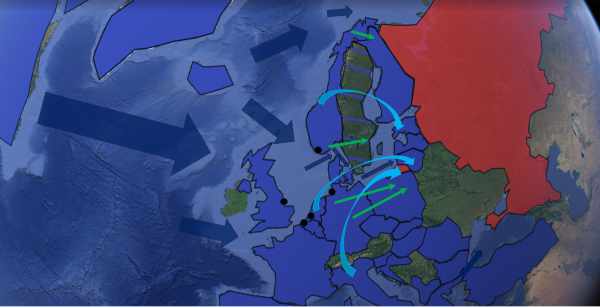
Figure 2 Visualizing force projection in the Baltic Sea region enhances the comprehension of the vast scope of the operation
Interestingly, some argue for a new approach to force projection, as the concept that proved effective against regional adversaries has limitations when facing powerful military peer competitors.[26] Over the past decades, one such limitation has emerged as adversaries like Russia and China have responded to this unique Western global capability. They have designed their military to significantly increase the cost for NATO nations to project their forces near their borders. With a better understanding of some considerations when projecting NATO forces, the subsequent section discusses how the Russian General Staff designed its military to counter this perceived threat.
Russian military design principles
Over the years, the perception of NATO as a threat has significantly influenced the Russian General Staff’s approach to designing the Russian military. Whether perceived as a real or imagined threat, it tangibly influenced the development of the Russian force structure. This perception encompasses at least two military viewpoints over the years. First, despite NATO’s steadfast commitment to being a defensive alliance, Moscow’s observation of Western military forces deployed globally for offensive operations toppling unwelcome regimes in recent decades has highlighted the enormous military imbalance between Russia and NATO.[27] Additionally, the Russian government has considered its own status as an unwelcome regime in the eyes of the West. Second, the encroachment of NATO’s military infrastructure on the Russian Western border has reduced their strategic depth.[28] The consequence of this diminishing geographical distance between NATO and Moscow carries negative military planning considerations. It reduces reaction times, negates the strategy of trading space for time, and increases the risk of a decapitating first strike with Western high-technology precision-guided munitions. These two viewpoints have contributed to the Russian General Staff designing its military largely to interdict NATO offensive operations by disrupting force projection. Considering this Russian perception without being comprehensive, at least three design principles warrant consideration when analyzing the Russian military’s ability to interdict: warfare at an increased stand-off distance, aerospace defence, and radio-electronic warfare.
First, increasing stand-off distance enhances the General Staff’s ability to interdict NATO’s force projection by striking deep into the battlefield. This allows for disrupting NATO’s rear area where they sustain their operations. Activities in this rear area include receiving recently mobilized forces in theatre intended to reinforce front lines, setting up maintenance hubs to keep equipment operational, and managing operations through a command post network. In the General Staff’s view, during a potential military conflict NATO’s rear area includes countries such as Norway, the Netherlands, Belgium, and Great Britain because they are vital in sustaining operations in the Baltic Sea region. The only possibility of striking NATO targets such as seaports and airfields is using long-range precision-guided munitions with ranges of several thousands of kilometres. With this goal in mind, the Russian military developed ground, air, and sea-launched ballistic and cruise missiles to disrupt force projection and increase NATO’s cost of sustaining offensive operations.
The second design principle is to strengthen aerospace defence.[29] The overwhelming impact of the US Air Force on the 1991 Operation Desert Storm left a profound impression on Russian military planners. The fear of a Desert Storm-style air campaign directly affected Russian force development and structures since the 1990s. It prioritized air defence over other services, resulting in the Russian Aerospace Defence forces currently having modern, redundant air defence systems. The Russian military organized most of its short-range air defence in the Ground Forces and its longer-range systems in the Aerospace Defence Forces.[30] While the short-range systems’ aim is to protect maneuvre brigades and divisions, the idea behind deploying long-range systems in the Baltic Sea region is to respond to the perceived threat of a NATO air campaign. The Russians integrated their air defence system with Belarus into a belt with overlapping protection, a common air picture, and centralized command and control, likely from the Joint Strategic Command West headquartered in Saint Petersburg.[31] This design principle directly impacts the Western assumption that arose during counter-insurgency operations in the past decades of ground forces operating with air superiority.
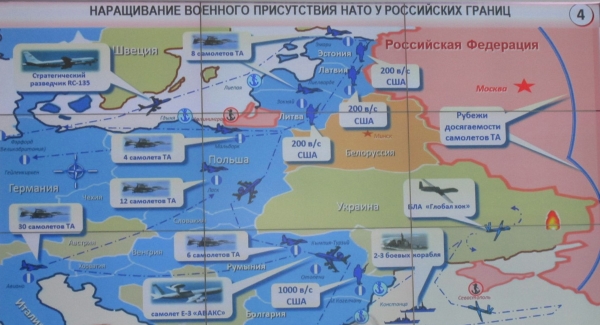
Figure 3 During a presentation in 2015, Deputy Chief of the General Staff Kartapolov visualized the perceived threat of Western air power to the Russian homeland[32]
The final design principle facilitating interdiction is radio-electronic warfare, which aims to achieve effects in the electromagnetic spectrum.[33] The Russian General Staff views information support to NATO military units as crucial to its fast-paced, high-technology style of warfare.[34] As a result, they have developed a doctrine that anticipates disrupting NATO command and control nodes to slow force projection and operational tempo.[35] Some of the modern Russian radio-electronic warfare systems can jam, disrupt, spoof, suppress, or intercept signals from satellites, radars, communication systems, and precision munitions guidance systems. Indeed, after analyzing Operation Desert Storm, Russian observers noted that space-based systems were ‘the basis of all technical reconnaissance’ during the war.[36]
While capabilities for stand-off warfare, aerospace defence, and radio-electronic warfare are not the only design principles that NATO must consider, they significantly affect the alliance’s ability to project force in the Baltic Sea region. Additionally, they involve what many commentators define as the Russian strategy of anti-acces/area denial (A2AD) in the Baltic Sea region. This strategy aims to prevent opposing forces from entering an area and reduce their ability to operate in it. As such, it reflects the Russian approach well. However, A2AD is not a strategy commonly used in Russian military discourse. With a better understanding of these principles, the below section of this article will delve into specific Russian maritime, aerial, and ground weapons systems.
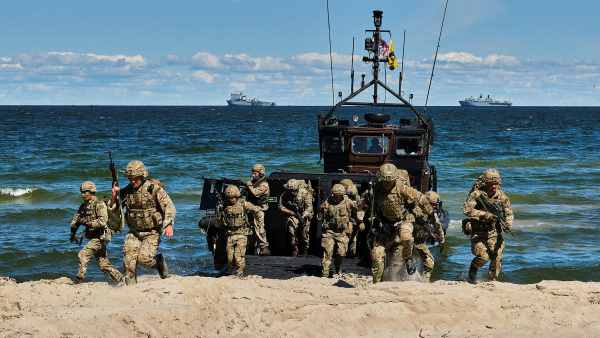
Royal Marines practice an amphibious landing at Kolga Bay, Estonia. The Russian Baltic Fleet’s capabilities reflect a limited Baltic Sea denial doctrine designed to prevent NATO naval forces from realizing their full military potential. Photo UK Ministry of Defence/Crown copyright, Si Ethell
Russian interdiction of NATO force projection
Since 2022, numerous media outlets and think tanks have highlighted the lackluster performance of the Russian army in Ukraine. In fact, in the initial phase following the invasion on February 22, 2022, Russia was unable to seize control of Kyiv and decapitate the Ukrainian government. The General Staff currently – in the Spring of 2024 – lacks the necessary forces to decisively breach Ukrainian defensive lines and conclude the war on terms favorable to Moscow. While many think tank reports assess the Russian military, few highlight the discrepancy between its design and usage in Ukraine. A ground-centric offensive campaign to conquer territory in Ukraine is not the intended purpose of the General Staff’s design of the Russian military. Over the past decades, Moscow designed a military for homeland defence, driven by the perceived threat of NATO offensive operations near Russian borders. It is not designed for territorial expansion. Indeed, the utility of military forces today often hinges on a nation’s threat perception from previous years. Without being exhaustive, the following section delineates which components of a potential Western force projection operation are vulnerable to interdiction by specific Russian weapon systems across domains.
Interdicting force projection of ground forces
The principles of Russian military design have resulted in specific weapons systems to counter the perceived threat of NATO projecting ground forces to the Baltic Sea region. Across all domains, the Saint Petersburg-based Operational Strategic Command West’s inventory includes precision-guided munitions designed to impose high costs on any attempt to reinforce the Baltic States. First, although the Russian Navy lacks the substantial submarine capability to interdict the sealift of US divisions across the Atlantic, seaports of debarkation in Western Europe are at risk. With a straight line distance of just under 2,000 kilometres between Moscow and the port of Bremerhaven, the latter is within reach of salvos of air-launched KH-101 and ground-launched 9M729 cruise missiles. The KH-101 is a low-flying missile built with radar-absorbing materials to evade radar detection and carries a conventional warhead, while the KH-102 is the nuclear variant.[37] The difficulty locating mobile launchers from which Russian crews fire the 9M729 poses a challenge for NATO targeting.[38] Targeting critical infrastructure is a fundamental premise of Russian operational planning, as regularly demonstrated by the General Staff in Ukraine. Disrupting the reception of the RSOI process with salvos of cruise and ballistic missiles is a realistic response option when Moscow deems war with NATO as inevitable.
Second, assuming a safe arrival at a seaport of debarkation, the onward movement of ground forces from Western Europe to the Baltic States requires rail or road transport. Interdicting this part of the RSOI process is a bigger challenge for the Russian military. Targeting transport infrastructure like bridges and railroad junctions to disrupt sustainment, a goal akin to Eisenhower’s Transportation Plan from 1944, requires combat aircraft in addition to precision-guided munitions to achieve significant degradation. However, despite the strength of the Russian and Belarussian integrated air defence system, it seems highly unlikely that the General Staff can maintain air superiority over Germany and Poland for a sustained period to allow Russian combat aircraft to execute such a mission. Indeed, if force projection of NATO ground forces shifts into high gear, the chance of the General Staff taking the initiative during the initial phase of the conflict is lost. Nevertheless, they have more flexible maritime and aerial force projection options because ships and airfields are better targets for precision-guided munitions and are more technology-dependent. In sum, within the force projection process, the Russian military possesses the capacity to impose high costs by interdicting the deployment of ground forces to the European theatre and the reception in various ports. However, preventing allied forces from moving within the theatre in small packages by road or rail into the Baltic Sea region is harder for the Russian General Staff to interdict.
Interdicting maritime force projection
The Russian Baltic Fleet’s capabilities reflect a limited Baltic Sea denial doctrine designed to prevent NATO naval forces from realizing their full military potential.[39] Highlighting a few capabilities that reflect Russian design principles, the 25th Coastal Missile Brigade in Kaliningrad likely possesses one Bastion-P and two Bal battalions, each equipped with four launchers for anti-ship missiles.[40] The transportable Bastion-P launch system can fire the P-800 Oniks missile, which has a range of approximately 300 kilometres.[41] The 3K60 Bal system launches the KH-35 missile, which is capable of engaging targets at 120 kilometres. The brigade participated in the Ocean Shield exercise from August 2-18, 2023, set up to test the readiness of the Baltic Fleet to operate in the Baltic Sea.[42] Training areas received a deployment of approximately 200 military personnel to simulate launches with Bastion-P and Bal anti-ship systems. Similar to the 9M729 ground-launched cruise missile, both the Bastion-P and Bal systems are mobile road systems, complicating effective Western targeting. In addition, the Russian Navy currently operationalizes the hypersonic 3M22 Tsirkon sea-launched cruise missile, which has an approximate range of 1,000 kilometres.[43] Its supposed speed of Mach 8 and potential maneuverability make it hard to intercept.[44]
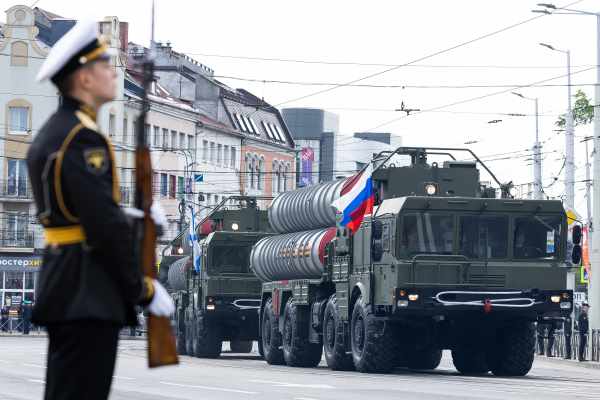
Russian show of force in Kaliningrad during the May 9, 2024 military parade dedicated to the 79th anniversary of Victory in the Great Patriotic War. Photo ANP/Kommersant/Sipa, Aleksandr Podgorchuk
Since 2019, the Baltic Fleet’s 841st Electronic Warfare Center has likely been operating its first Murmansk-BN complex, a modern system designed to jam high-frequency communication over a range of several thousand kilometres for operations in the electromagnetic spectrum. Additionally, it can interfere with communication between satellites and combat units, making it harder to complete the Observe-Orient-Decide-Act (OODA)-loop for the targeting-to-kill cycle. Murmansk-BN can deprive NATO naval forces of navigation and communication and stop onboard weapon systems from functioning.[45] In sum, Russian naval forces in and around the Baltic Sea region are well equipped to increase NATO’s cost of maritime deployment and employment in the force projection process.
Interdicting aerial force projection
The projection of US air power during Desert Storm left a profound impression on the Russian military. Therefore, similar to targeting seaports of debarkation, airfields are likely high on the Russian target list to increase the cost of force employment in the theatre. In addition, the integrated IADS with Belarus and radio-electronic warfare are critical priority areas for countering NATO air power.[46] The Russian-Belarussian IADS consists of an interconnected, layered constellation of radars and SAMs, commanded and controlled by the Russian Operational Strategic Command in Saint Petersburg. Its flexible approach to air defence encompasses various SAMs, from inexpensive short-range missiles to low-flying aircraft and cruise missiles to long distance missiles. The SA-21 and SA-23 SAMs can fire 40N6 missiles that can potentially engage targets at 400 kilometres. Although targeting fighter aircraft at such a range is challenging, it puts less agile aircraft like AWACS at risk.[47] In addition, Russian and Belorussian Army brigades and regiments have short- and medium-range air defence systems to maneuver with, further strengthening the IADS. Indeed, forward-deployed ground forces within a Russian Baltic Sea region concept of operations increase the depth of the IADS, putting NATO air operations at high risk during the initial weeks of a military conflict.
Furthermore, NATO air power is also impeded by Russian capabilities to interfere in the electromagnetic spectrum. Specifically designed to counter Western flying Intelligence, Surveillance, and Reconnaissance (ISR) platforms, the 1RL257 Krasukha-4 can disrupt low-earth orbit satellites and airborne radars such as AWACS up to 300 kilometres away.[48] The Russian operational commander for the Baltic Sea directly oversees the 15th and the 16th Independent Electronic Warfare Brigades.[49] Each brigade consists of four battalions, which ‘seek to confuse and deceive opposing force military decision-makers.’[50] With these brigades, the operational commander can strengthen the main effort of his concept of operations. In sum, despite a significantly disadvantageous balance of air forces relative to NATO, a clever Russian threat-driven force design partly compensates for this and can impose severe costs on a Western air campaign. Indeed, the Russian military punches above its weight because it is designed for a specific task.
Conclusion and recommendations
Russian setbacks on the battlefield in Ukraine do not a priori indicate a weak Russian military. Neither did Western battlefield setbacks – of which there were plenty – during counterinsurgency operations in Afghanistan. Indeed, the Russian military can impose high costs by interdicting NATO force projection in the Baltic Sea region. They developed concepts and weapon systems across all domains to address this specific perceived military problem. NATO staff officers making operational plans to project forces to the Baltic Sea region have at their disposal force structures largely designed to execute counterinsurgency operations in the Middle East. The Russian General Staff augments the alliance’s challenge of force projection by addressing this threat head-on. This article aimed to contribute to a better understanding of the Russian General Staff’s ability to interdict NATO force projection. Within the force projection process, ground forces are vulnerable when mobilizing and deploying into the European theatre but less so when moving onward in small packages to their tactical combat areas by road or rail. In contrast, maritime and air forces face their biggest challenge in employing their military power. From a military perspective, the Baltic Sea region is heavily fortified. Precision-guided munitions, the Russian-Belorussian IADS, and radio-electronic warfare are just some of the systems that impede the deployment, employment, and sustainment of NATO forces in a potential military conflict with Moscow. With the Russian defence industrial base mobilized more successfully than previously assumed possible, the near future will likely not see a weakened Russian military.[51] The General Staff continues to develop operational plans for being – at least partly – successful on the battlefield.
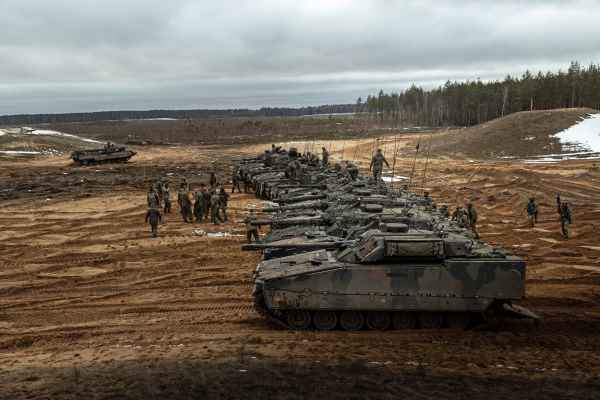
The Dutch 43 Mechanised Brigade, part of the enhanced Forward Presence in Lithuania. NATO should re-think force projection conceptually and prioritize rail, road, and inland waterway movement. Photo MCD, Aaron Zwaal
Operational implications and recommendations
Moving forward, NATO planners should consider four options to better address the imposition of costs on their battlefield plans:
- Prioritize SEAD/DEAD during the initial phase of a potential war. Reserving F-35 squadrons for this specific task in the unlikely event of an Article 5 scenario is highly inefficient, costly, and almost impossible to justify. However, it is also highly effective in combat, will save many soldiers’ lives, and makes the military leader defending it now a retrospective hero at the war’s end.
- Use phasing in NATO’s operational plans in line with prioritizing SEAD/DEAD. Depending on the time and space forces need before employment and opposing some of the ‘integration’ and ‘Multi-Domain’ logic currently fashionable in NATO circles, not all domains have an equal part to play in each phase. The successful phasing of Operation Desert Storm is a helpful framework. Currently, within the European theatre, ground forces, with the exception of those already in place, will likely be slower to arrive on the battlefield than maritime and air forces. However, they are indispensable for regaining lost territory once conditions like air superiority are set.
- Prioritize rail, road, and inland waterway movement for combat units to arrive on the battlefield in the theatre. This involves harmonizing or eliminating hampering legislation across NATO nations to improve military mobility. Additionally, NATO nations should be encouraged to improve their road, rail, and inland waterway networks with the enormity of effort that military force projection entails, and encourage investments in civil-military cooperation for deploying, employing, and sustaining forces for large-scale combat. Closer cooperation between the EU and NATO can significantly speed up this process.
- Re-think force projection conceptually. The force design of many NATO militaries is insufficient for the enormous scope of deploying, employing, and sustaining forces on the battlefield in the Baltic Sea region. Some experts argue NATO should increase its prepositioned forces at its eastern flank. Indeed, permanent forces and prepositioning stocks are part of the solution to address the impediments the Russian military imposes. Additionally, it reduces the Russian perceived chances of success by executing a pre-emptive operation in the Baltic Sea region by essentially taking away the Russian advantages during the initial phase of a potential war.
[1] William W. Momyer, Air Power in Three Wars (Washington, D.C., Government Printing Office, 1978) 164.
[2] Eduard Mark, Aerial Interdiction. Air Power and the Land Battle in Three American Wars (Washington, D.C., Center for Air Force History, 1994) 238.
[3] Ibidem.
[4] John A. Snider, ‘Air Interdiction. Focus for The Future,’ GlobalSecurity.org (1990).
[5] Eduard Mark, Aerial Interdiction, 1.
[6] Jerry Russel, ‘Ultra and the Campaign Against the U-boats in World War II,’ (Carlisle Barracks, U.S. Army War College, 1980) 4.
[7] Aundre F. Piggee, ‘A 100-Year-Old Question: Are You Ready to Move Today?,’ Army Sustainment (March-April 2018) 3-4.
[8] Michael J. Mazarr, ‘Toward a New Theory of Power Projection,’ War on the Rocks (15 April 2020).
[9] Bruce Busler, ‘Strategic Mobility in the Context of U.S. National Defense Strategies,’ Joint Forces Quarterly 107 (4th quarter, 2022) 79.
[10] Jim Garamone, ‘Air-Refueling, Sealift Recapitalization Is Key to U.S. Logistical Dominance, (Washington, D.C., U.S. Department of Defense, 2023); Bruce Busler, ‘Strategic Mobility,’ 80.
[11] Ibidem.
[12] Tory Darr, ‘NATO tests new regional ‘deterrence and defense’ plans,’ (Defense Visual Information Distribution Service, 2023).
[13] Sven Biscop, ‘The New Force Model: NATO’s European Army?,’ Egmond Policy Brief 285 (2022) 1.
[14] Emily Ferris, ‘Russia’s Railway Troops. The Backbone Sustaining Russian Military Force Posture,’ (Arlington, CNA, July 2023).
[15] Ibidem, 1.
[16] Ibidem, 5.
[17] Victor G. Addison, ‘The Answer Is the Carrier Strike Group... Now, What Was the Question?,’ Proceedings, Vol. 136/7/1,289 (July 2010).
[18] Christopher H. Elliott, ‘The Carrier Strike Group. Examining Approaches To Forward Presence,’ (Monterey, Naval Postgraduate School, 2016) 15.
[19] Royal Australian Air Force, ‘F-35A Lightning II.’
[20] Justin Bronk, ‘Getting Serious About SEAD. European Air Forces Must Learn from the Failure of the Russian Air Force over Ukraine,’ (London, RUSI, 6 April 2022).
[21] Ibidem.
[22] Peter Roberts, ‘The Credibility of NATO depends on DEAD,’ This Means War podcast with Justin Bronk (11 May 2023).
[23] Ibidem.
[24] Andrew Salerno-Garthwaite, ‘Article 5 contingency sparks largest air deployment in Nato history,’ Air Force Technology (12 June 2023).
[25] Edwin Schimmel, ‘NATO Wraps Up Air Defender 2023, Its Largest Ever Air Exercise,’ The Aviationist (26 June 2023).
[26] David Ochmanek, ‘Restoring U.S. Power Projection Capabilities,’ (Santa Monica, RAND Corporation, 2018) 8.
[27] Richard Sokolsky, ‘The New NATO-Russia Miloitary Balance. Implications For European Security,’ (Carnegie Endowment for International Peace, 2017) 1-2.
[28] See for example comments by Dimitry Peskov after Finland joined NATO: Andrew Osborn and Jake Cordell, ‘Russia says Finland’s NATO accession is dangerous historic mistake,’ Reuters (4 April 2023).
[29] ‘Russia Military Power,’ (Washington, D.C., Defense Intelligence Agency, 2017) 33.
[30] Mason Clark and Karolina Hird, ‘Russian Regular Ground Forces Order of Battle,’ (Washington, D.C., Institute for the Study of War, 12 October 2023) 47. https://www.understandingwar.org/backgrounder/russian-regular-ground-forces-order-battle-russian-military-101.
[31] Bob Deen, Barbara Roggeveen and Wouter Zweers, ‘An Ever Closer Union? Ramifications of Further Integration between Belarus and Russia,’ (The Hague, Clingendael Report, 9 August 2021) 25. https://www.understandingwar.org/backgrounder/russian-regular-ground-forces-order-battle-russian-military-101.
[32] Russian Military Reform, blog by Dimitry Gorenburg, https://russiamil.wordpress.com/2015/05/.
[33] Radio-electronic warfare is the term used by the Russian military for what many Western militaries call electromagnetic warfare.
[34] ‘Russia Military Power, 36.
[35] Timothy L. Thomas, ‘Russian Military Thought. Concepts and Elements,’ (McLean, MITRE, 26 August 2019) 6-2: https://www.mitre.org/news-insights/publication/russian-military-thought-concepts-and-elements.
[36] Mary C. FitzGerald, ‘Russian Views on Electronic and Information Warfare: Volume II,’ (Washington, D.C., Hudson Institute, 1996) 141.
[37] Missile Defense Project, ‘Kh-101/Kh-102,’ Missile Threat (Washington, D.C., Center for Strategic and International Studies, October 26, 2017, last modified July 31, 2021).
[38] Missile Defense Project, ‘9M729 (SSC-8),’ Missile Threat (Washington, D.C., Center for Strategic and International Studies, October 23, 2018, last modified March 31, 2022).
[39] Fredrik Westerlund and Susanne Oxenstierna (Eds.), ‘Russian Military Capability in a Ten-Year Perspective – 2019,’ (Stockholm, FOI, December 2019) 30 https://www.foi.se/rapportsammanfattning?reportNo=FOI-R--4758--SE.
[40] Jonas Kjellen, ‘The Russian Baltic Fleet. Organisation and Role within the Armed Forces in 2020,’ (Stockholm, FOI, 2021) 52.
[41] Center for Strategic and International Studies, ‘P-800 Oniks/Yakhont/Bastion (SS-N-26 Strobile),’ (Washington, D.C., CSIS Missile Defense Project, 2021).
[42] Milosz Gapinski, Ireneusz Kulesza and Konrad Muzyka, ‘Ocean Shield 2023. The Baltic Fleet’s Perspective,’ (Rochan Consulting, 2023) 6.
[43] Akshai Vikram, Russia’s New Nuclear Weapons. Understanding Avangard, Kinzhal, and Tsirkon,’ (Washington, D.C., Center for Strategic and International Studies, 2021).
[44] Jill Hruby, ‘Russia’s New Nuclear Weapon Delivery Systems. An Open-Source Technical Review,’ (Washington D.C., NTI, 2019) 22.
[45] Ibidem.
[46] Justin Bronk, ‘Modern Russian and Chinese Integrated Air Defence Systems. The Nature of the Threat, Growth Trajectory and Western Options,’ (London, RUSI, 2020) 15.
[47] Ibidem 16.
[48] ‘Krasukha-4 1RL257 Broadband Multifunctional Jamming Station’, Armyrecognition.com.
[49] Konrad Muzyka, ‘Russian Forces in the Western Military District,’ (Arlington, CNA, 2021) 27.
[50] Morgan J. Spring-Glace, ‘Return of Ground-Based Electronic Warfare Platforms and Force Structure,’ Military Review (July-August 2019) 42.
[51] ‘Russian Offensive Campaign Assessment,’ (Washington, D.C., Institute for the Study of War, December 29, 2023).